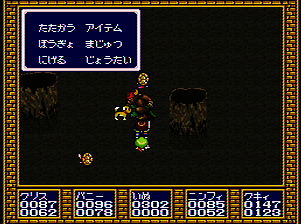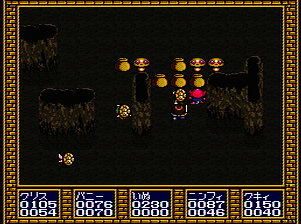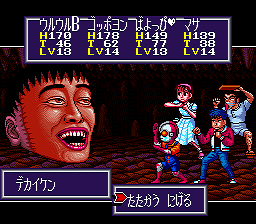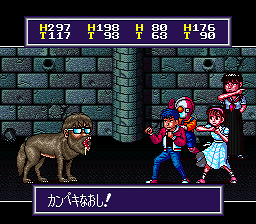At the end of the last session I had gotten to the point where the end goal was clear — get to Maka Maka castle and defeat Maka Maka to stop the world from being turned into water fleas. Yeah.
Next up is New Queen Town, where a monster has taken over the queen’s position. She forces you to take off all your clothes.
 |
| “What an idiot, to show your dick before an enemy! Now do a naked dance!” |
Fortunately Goyoppo is able to escape, and then we can head out to a Botan tree to get a fruit that will block the woman’s attack. This is a good place to level because you meet an enemy called Tome-san. Normally he heals one of your characters and then runs. But if you use the main character’s “Zako destroyer” move, it will kill him and give you 10,000 XP. With the Ul Ul Car you can keep running into the mountains over and over and getting into battles. This is the best place I found to level right up to the end of the game. You will meet one other odd character called Andou, a shirtless dancing man. He heals your characters 1000 HP, but this causes a bug that overflows your HP and makes you die in one hit in the next battle.
 |
| Thank you Tome-san |
With the fruit in hand, time to fight the Baseran, alone:
 |
| Vaseran? Baseran? |
These solo fights are annoying because the enemies do too much damage.She’s weak to ice so the main character can do pretty well, but you can still get criticalled and die.
The next step is to go to a secret factory and try to stop the Maka Maka plan.
 |
| Here’s a glitch where townspeople have turned into palette swapped Johnny |
People at the factory tell you that if you can bring a rare gem and throw it in the cauldron, it will destroy the machine. The only place you can find that is in the South Country, so it’s back to the islanders, and this time Cynthia has to join your party in place of your girlfriend, who runs away upon finding out you married Cynthia.
Unfortunately as I said earlier, Cynthia’s portrayal is pretty bad; Japan has its own colonial past with pacific islands, and isn’t always kind in their depiction. They also may have been influenced by older Disney cartoons. I apologize for this, but here’s Cynthia’s battle sprite:
 |
| The less said the better |
Cynthia has the stone necessary, and you throw it in. Unfortunately we got tricked — the helpful people were actually Maka Maka group, and throwing in the stone is what activates the device and turns most of the world into water fleas. Actually when you go to the town it’s partially glitched because only about half the sprites change to water fleas even though most of the town inhabitants speak like they’ve been changed.
Now we need to obtain a means of flying to move on with the game. Remember the “big hand woman” from the last post? She’s still serving as the ship’s rudder, but if you bring the fat-head Mafia boss to her, she’ll cure him, he joins your party, and she gives you her big hands. Now you can flap the big hands to fly.
 |
| Oddest means of travel ever in an RPG? |
The next sequence involves fighting a vampire in order to get the Book of Rebirth so that we can go back into the past life. There are some fetch quests in here but I’ll just skip to the vampire fight. The enemy’s name (Dorakyue) is a pun on both Dracula and Draque (the shortening of Dragon Quest).
 |
| Trademark lawyers, turn away |
The big event here is that after you beat Dorakyue, the mysterious person controlling him is revealed to be your girlfriend! She thinks that her past life and clan is responsible for everything that’s happening and refuses to join you anymore. So it’s back to the past to find out what happened. This is a nice touch to the story; I assumed the “past lives” thing was just a throwaway joke to explain how your characters can use spells and techniques, but it actually does get worked into the story at this point.
In the past, you find the Shabashaba clan fighting the Nyabanyaba clan. The former is where the hero’s past self is from, and the latter is the girlfriend’s past self. We try to broker a peace, and it doesn’t work. But it turns out that the king of Nyabanyaba has had his position secretly taken over by his retainer, Maka Maka. Lemia (girlfriend’s past life) is a hostage, but she throws herself off the top of the palace so that Shalm (main character’s past life) can kill Maka Maka. He does so and then jumps to his death himself. Your party follows(!) but it turns out there were cushions underneath so everyone has survived. You receive a golden sword as well as a stone of light, which you can use to restore the girlfriend in the present world to her senses. (The Nyabanyaba castle has the strongest sword in the game but you have to pay 500,000 to identify it so I didn’t bother.)
Now all that remains is breaking the barrier around Maka Maka castle and going in to defeat the final boss. But first, we have to deal with the defense bug:
 |
| From left to right, “Attack”, “Defense”, Speed” |
Randomly in the latter half of the game, the defense stats of your hero, girlfriend, and Johnny will fluctuate — most often they go to 0, but apparently they can also go to 255. As you see in the picture above, the hero’s base defense is now 0. Fortunately the endgame is easy so this didn’t matter.
In order to open the barrier to Maka Maka castle, we have to revive the Phoenix for real. This requires setting up something in the past world so that we can get a fire stone in the real world. First, we have to get the ship in the past world. The ship is another glitchfest; most often it disappears when you land, so you have to make sure you remember where you parked it. But often there are two or three ships on the screen, or the ship itself is glitched.
 |
| Maybe it’s supposed to be two separate ships. |
This is actually an interesting part of the game because you can travel around the past world and meet all the past lives of your party members, and see small scenes that will give them additional spells, weapons, or armor. All of this is optional, though. All you really have to do is see one scene that lets you pick up a fire stone in the present world, then you get the Phoenix:
 |
| That glitched square flies around the screen while you’re on the Phoenix |
Now we can finally break the Maka Maka barrier, killing the Phoenix in the process, and defeat Maka Maka himself. There are five set encounters you have to beat before you can reach him. Fortunately they’re fairly easy. Ul Ul Boy has a spell that makes you invulnerable for 3 rounds, so if you just use that you can beat every enemy without taking any damage, even the final boss. The only exception is the “atomic zako”, which kill you automatically if they get a turn, so you have to beat them before they can do that. Girlfriend is the only one who had enough speed for me, so I used her area fire spell.
Here’s Maka Maka, the final boss:
 |
| !? |
He does have a second form:
 |
| Now see my true power! |
The first form is tough (if you don’t use UB’s barrier), but the second form has 1 HP. I think this was actually an intentional joke, not a bug, although you can never be sure with this game.
Having defeated Maka Maka, the world is saved, and 1 year later there are three marriages (Main Character-Girlfriend, Johnny-Cynthia, and Michi-Michael). Of course, the ending scene has to have a bunch of graphical glitches:
 |
| Dr. Pascal is supposed to be talking to us, but he walked through the walls and went to the wrong place |
 |
| Michael and Michi are half cut off, and there are glitched figures at the top |
Then the coup de grace; the credits sequence is glitched so that none of the names can be read. Every so often one will pop up that is legible, but they’re all fake names anyway.
 |
| Really, could there be a more fitting credits sequence? |
So that’s Maka Maka. It’s amazing this piece of garbage was released. I’ll post my review on Saturday and try to address the question of whether this would have been a good game if it hadn’t been so buggy.











































